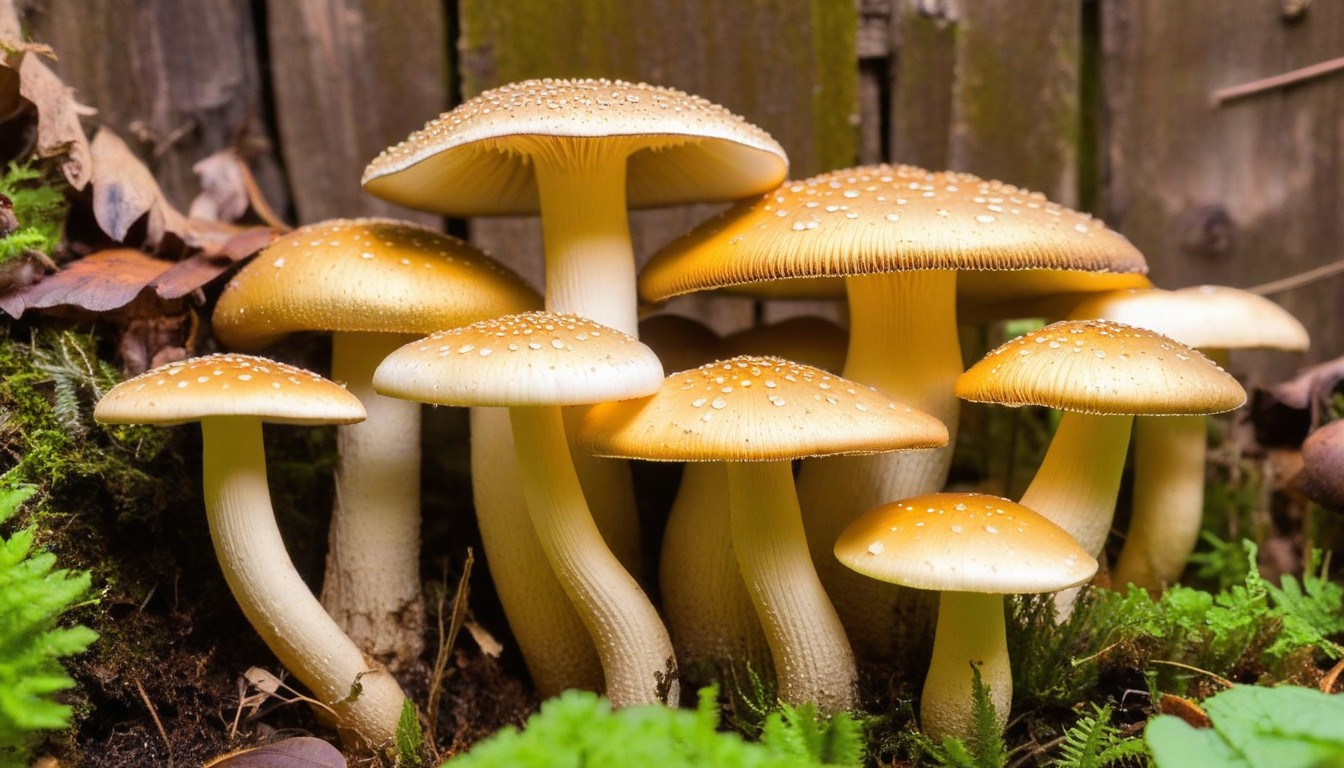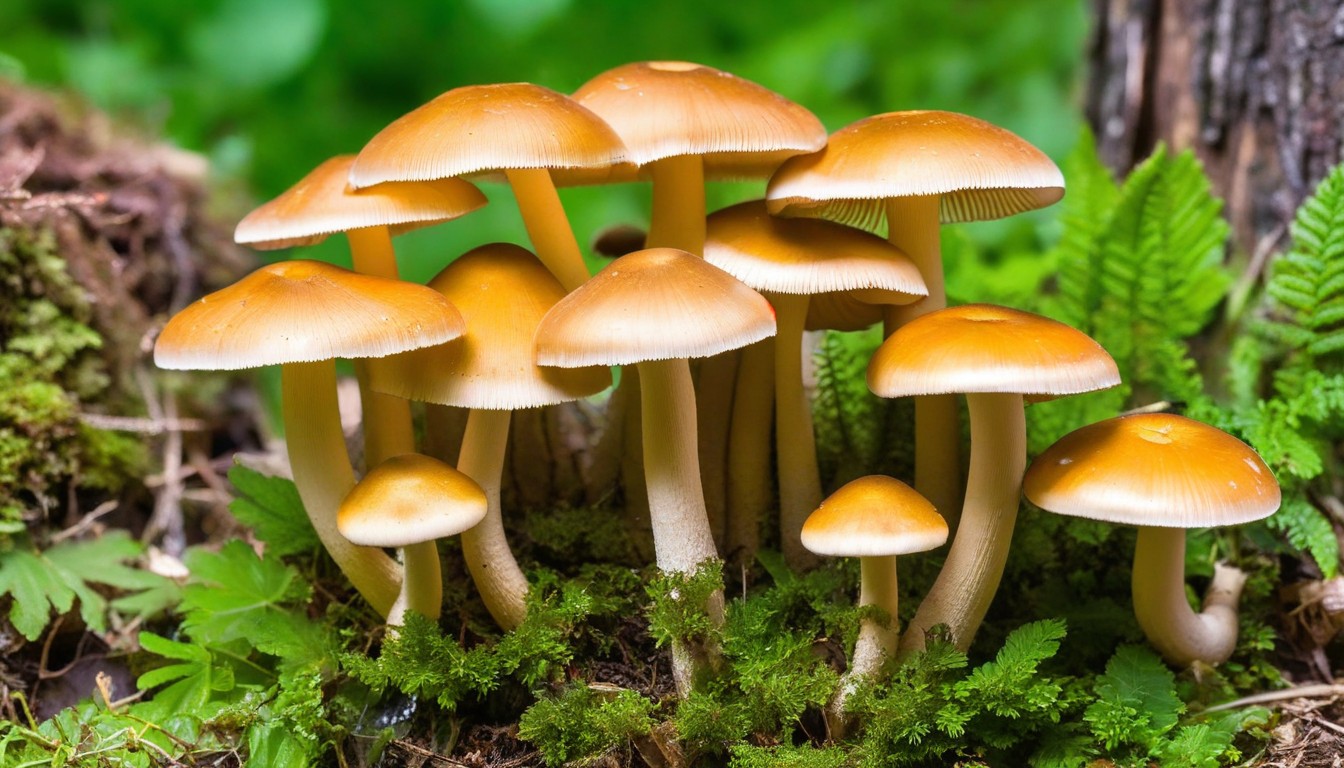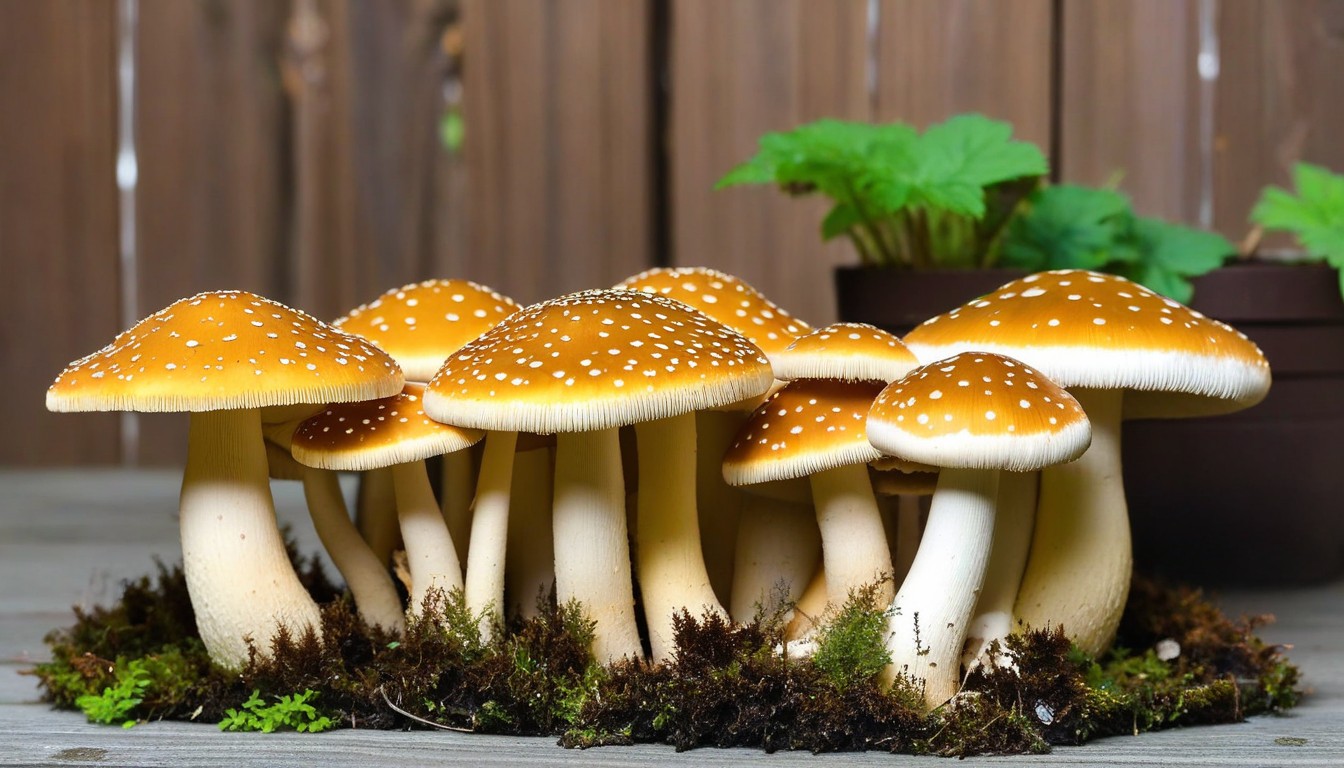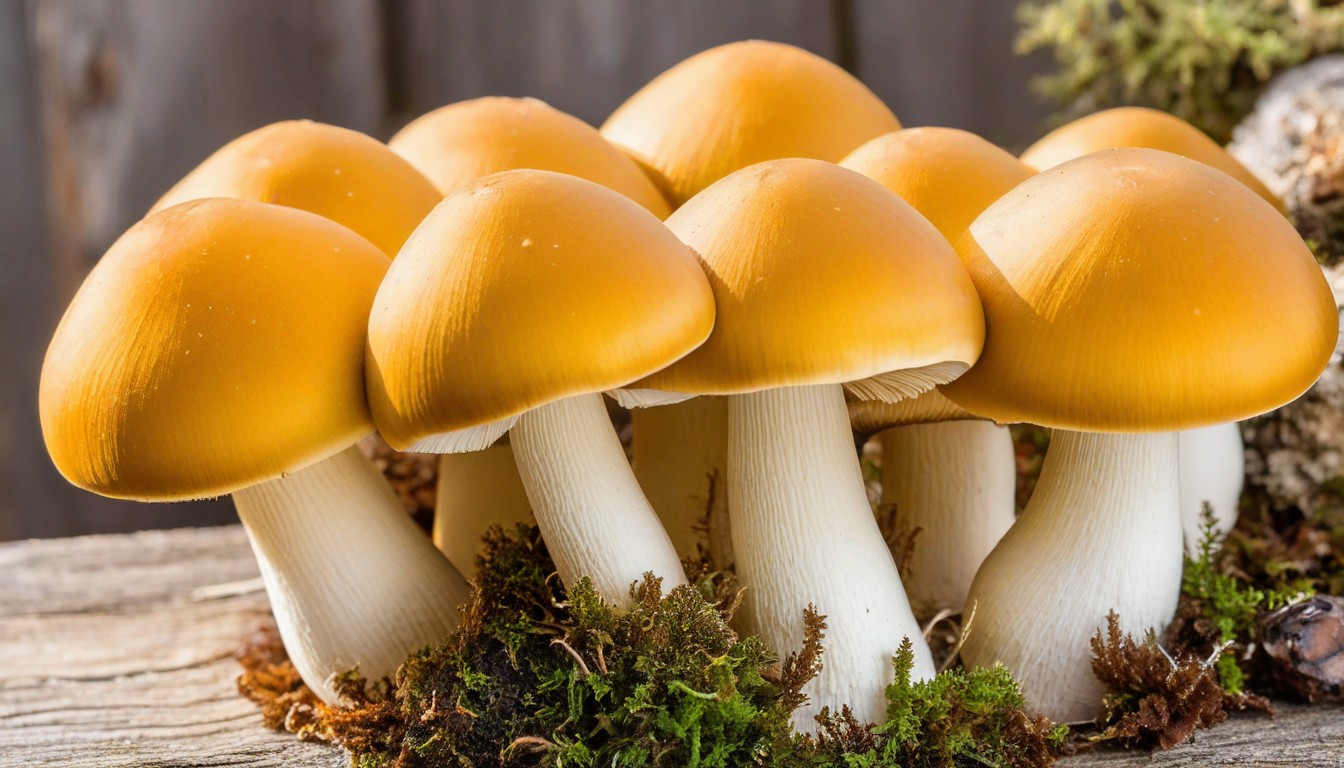Welcome to our comprehensive guide on growing Golden Teacher Mushrooms at home! Whether you are a seasoned cultivator or a beginner, this guide will provide you with valuable insights and techniques to successfully cultivate these unique and awe-inspiring mushrooms in the comfort of your own home.
With their distinct appearance and psychedelic properties, Golden Teacher Mushrooms are a popular choice for home cultivation. By following our step-by-step process, you can create an optimal growing environment and produce healthy and potent mushrooms.
Key Takeaways:
- Golden Teacher Mushrooms are a unique and popular mushroom for home cultivation.
- This comprehensive guide will provide valuable insights and techniques for successful cultivation.
- Following the step-by-step process will help create an optimal growing environment and produce healthy and potent mushrooms.
- With proper care and maintenance, you can grow your Golden Teacher Mushrooms and enjoy their benefits in the comfort of your own home.
Understanding Golden Teacher Mushrooms
Before embarking on the cultivation journey, it’s important to understand the characteristics and psychedelic properties of Golden Teacher Mushrooms. These fascinating mushrooms have unique traits and offer a range of potential benefits.
Characteristics of Golden Teacher Mushrooms
Golden Teacher Mushrooms are recognizable by their golden caps with nipple-shaped protrusions and thick white stems. They are a type of psilocybin mushroom, which means they contain the psychoactive compound psilocybin that induces feelings of euphoria, altered thinking, and sensory distortions when ingested in adequate doses.
Golden Teacher Mushrooms are known for their moderate potency, often generating a less intense trip than other psilocybin strains like Penis Envy or Thai. They are a popular choice for beginners as they can produce a more manageable experience.
Psychedelic Properties of Golden Teacher Mushrooms
Golden Teacher Mushrooms have gained popularity in the psychedelic community for their reported therapeutic properties, which include reduced anxiety, depression, and obsessive-compulsive disorder (OCD). They are also said to improve creativity, focus, and spiritual experiences.
Golden Teacher mushrooms have a unique ability to teach people about themselves and the world around them.
It’s important to note that these potential benefits are still being researched, and psilocybin mushrooms should only be taken under the guidance of a trusted expert or medical professional.
Obtaining Golden Teacher Mushroom Spores
Golden Teacher Mushroom spores are essential for home cultivation. Choosing a reputable source for spores is crucial to ensure successful growth and minimize the risk of contamination.
Where to buy Golden Teacher Mushroom spores
There are several online retailers that offer high-quality Golden Teacher Mushroom spores for purchase. It is important to research and read reviews before making a purchase to ensure that the vendor is reputable and offers quality spores.
What to look for in Golden Teacher Mushroom spores
When selecting spores, it is important to choose ones that are fresh, viable, and free of contamination. Look for spores that have a dark color and smooth texture. Avoid spores that appear discolored or have a rough surface.
Factors to consider when selecting Golden Teacher Mushroom spores
|
Factor |
Description |
|---|---|
|
Quality |
Ensure the spores are of high quality, fresh, and viable. |
|
Price |
Compare prices from different vendors to find the best deal. |
|
Reputation |
Check the vendor’s reputation by reading reviews from previous customers. |
By considering these factors, you can choose the best Golden Teacher Mushroom spores for your cultivation needs.
Choosing the Right Substrate for Golden Teacher Mushrooms

Growing Golden Teacher Mushrooms requires choosing the correct substrate that provides nutrients and promotes mycelium growth. The substrate is the growing medium that the mushrooms will use to extract nutrients to support the fruiting process. A good substrate must be nutrient-rich, sterile, and hold enough moisture to support mushroom growth.
Here are some of the substrates that are commonly used for growing Golden Teacher Mushrooms:
|
Substrate |
Description |
|---|---|
|
Straw |
Straw is a popular substrate for growing Golden Teacher Mushrooms due to its high nitrogen content and ability to support mycelium growth. |
|
Compost |
Compost is a rich source of nutrients and can be used as a substrate for Golden Teacher Mushrooms. It can be made from household waste, such as vegetable scraps and coffee grounds. |
|
Sawdust |
Sawdust is another popular substrate for Golden Teacher Mushrooms. It is easy to work with, and the fine texture provides a large surface area for mycelium growth. |
When choosing a substrate, it’s important to consider its availability, cost, and ease of use. Also, the substrate must be pasteurized or sterilized before inoculation to eliminate any bacteria or fungi that could compete with the mushroom mycelium.
Using a substrate that has been prepared correctly and is nutrient-rich is essential for cultivating healthy Golden Teacher Mushrooms.
Preparing the Substrate for Golden Teacher Mushrooms

Proper preparation of the substrate is vital for successful growth of Golden Teacher mushrooms. In this section, we’ll discuss the steps involved in substrate preparation, as well as the techniques for sterilizing it to create an ideal environment for cultivation.
Choosing the Right Substrate
Before starting the preparation process, it’s crucial to choose the right substrate for your Golden Teacher mushrooms. The common substrates used for cultivation include straw, compost, and sawdust.
Preparing the Substrate
The substrate preparation process will vary depending on the chosen substrate. In general, the process involves soaking the substrate to hydrate it, pasteurizing it to kill unwanted microbes, and cooling it to inoculation temperature.
Sterilizing the Substrate
Sterilizing the substrate is an essential step that ensures the growth of healthy mycelium without the presence of harmful bacteria or fungi. Sterilization can be done using various methods such as pressure cookers or autoclaves, depending on the substrate used.
Note: Always ensure that the substrate is cooled down completely before inoculation to prevent the death of spores or mycelium.
By following the substrate preparation and sterilization techniques thoroughly, you can create a conducive growing environment for your Golden Teacher mushroom cultivation. In the next section, we’ll explore the techniques of inoculating the substrate with Golden Teacher mushroom spores.
Inoculating the Substrate with Golden Teacher Mushroom Spores
Once your substrate is prepared, it’s time to inoculate it with Golden Teacher Mushroom spores. Inoculation is the process of introducing the spores to the substrate so that they can colonize and grow into mycelium, the vegetative part of the fungus.
There are several techniques for inoculating Golden Teacher Mushrooms, including the spread method, the agar method, and the liquid culture method. The spread method involves spreading the spores onto the surface of the substrate, while the agar method involves growing the spores on agar plates before transferring them to the substrate. The liquid culture method involves growing spores in a liquid solution before inoculating the substrate.
Regardless of the technique you choose, it’s important to maintain a sterile environment during the inoculation process to prevent contamination. Use a clean workspace and sterilize all tools and equipment with rubbing alcohol or a bleach solution.
Here are some basic steps to follow for the spread method of inoculation:
- Sterilize a spoon or scalpel with rubbing alcohol or a bleach solution
- Open the spore syringe and draw up a small amount of spore solution
- Use the spoon or scalpel to transfer the spore solution to the surface of the substrate
- Cover the container with a lid or plastic wrap and incubate at the optimal temperature and humidity for Golden Teacher Mushrooms
- Wait for the mycelium to colonize the substrate
With patience and careful attention to detail, you can successfully inoculate your substrate with Golden Teacher Mushroom spores and set the stage for healthy mushroom growth.
Providing Optimal Growing Conditions for Golden Teacher Mushrooms
Golden Teacher Mushrooms are a unique and delicate species that require specific growing conditions to thrive. Providing these optimal conditions is crucial to ensure healthy and abundant mushroom growth. Below, we will discuss the temperature and humidity requirements needed to create an ideal environment for Golden Teacher Mushrooms.
Temperature Requirements
The ideal temperature range for Golden Teacher Mushrooms is between 68 and 77 degrees Fahrenheit (20-25 degrees Celsius). It’s important to maintain a stable temperature throughout the growing process, as fluctuations can cause stress and stunted growth.
To achieve and maintain the appropriate temperature, consider using a space heater or a heating pad. You can also place your mushroom grow box in a warm and isolated location, away from any drafts or changes in temperature.
Humidity Requirements
Golden Teacher Mushrooms require high humidity levels for optimal growth. The ideal humidity range is between 85 and 95 percent. These high humidity levels help keep the substrate moist and prevent the mushrooms from drying out.
To maintain high humidity levels, consider using a humidifier or a mister to provide consistent moisture to your growing environment. You can also cover your mushroom grow box with a humidifying tent or plastic wrap to trap moisture.
Lighting Requirements

In addition to temperature and humidity, lighting is an essential factor in Golden Teacher Mushroom growth. These mushrooms require indirect natural light or low-intensity artificial light to trigger the fruiting process.
Avoid exposing your mushroom grow box to direct sunlight, as this can cause overheating and dry out the substrate. Instead, place your grow box in a well-lit area or use a low-intensity bulb to provide the necessary lighting.
Air Exchange
Proper air exchange is vital for Golden Teacher Mushroom growth. Fresh air helps to remove carbon dioxide and provide the necessary oxygen for the mushrooms to thrive. It also helps prevent the build-up of harmful gases that can cause contamination.
To ensure proper air exchange, consider using a fan or opening the grow box at least twice a day to allow for fresh air and proper ventilation. Avoid opening the grow box for too long or in dusty or polluted environments. You can also install an air filter to improve the air quality in your growing area.
Caring for Growing Golden Teacher Mushrooms
Growing Golden Teacher Mushrooms requires regular care and maintenance. These are living organisms and need attention to thrive. Here are some essential tips to ensure healthy and robust growth of your Golden Teacher Mushrooms:
Watering
The substrate should be kept moist but not waterlogged. Overwatering can cause the substrate to become contaminated with bacteria or fungi, which can harm your mushrooms. Make sure to use filtered or distilled water instead of tap water, which may contain chlorine or other chemicals harmful to mushroom growth.
Ventilation
Proper airflow is crucial for Golden Teacher Mushroom growth. Fresh air helps to remove excess carbon dioxide and other gases that can accumulate in the growing container. Open the lid of the container periodically to allow fresh air to circulate, or use a fan to provide some air movement.
Temperature and Humidity
Golden Teacher Mushrooms grow best in temperatures ranging from 70-78°F (21-25°C) and humidity levels of 90-95%. Make sure to monitor these conditions regularly and make adjustments as needed. Using a hygrometer and thermometer is an excellent way to ensure the temperature and humidity levels remain constant.
Maintain Sterility
Sterility is essential for successful mushroom growth. Wear gloves when handling the substrate, and use a face mask to avoid breathing on it. Avoid opening the container unnecessarily to prevent contamination from the outside environment. If contamination does occur, remove the affected mushroom growth and dispose of properly to prevent it from spreading.
Pest Control
Pests like mites and flies can quickly infest your growing container, damaging your mushrooms. Make sure to keep the growing area clean and free of debris. You can use natural pest control methods like neem oil or sticky traps to keep unwanted critters away.
By following these care and maintenance tips, you can enjoy a healthy and abundant harvest of Golden Teacher Mushrooms, right from the comfort of your own home.
Recognizing Signs of Mushroom Growth and Maturation

As your Golden Teacher Mushrooms begin to develop, they will go through several distinct growth stages. Recognizing these stages can help you determine when it’s time to harvest your mushrooms for optimal potency. Here are the general growth stages for Golden Teacher Mushrooms:
|
Stage |
Description |
|---|---|
|
Spawn Run |
The first stage of colonization, during which the mycelium fully permeates the substrate. |
|
Pinheads |
Tiny mushroom caps beginning to form, resembling pinheads. |
|
Veil Breaking |
The veil covering the gills breaks as the cap expands. |
|
Mushroom Maturation |
The cap flattens out and the gills darken. Mushrooms are ready for harvest during this stage. |
It’s essential to harvest your Golden Teacher Mushrooms at the right stage of growth to achieve the desired effects. If you wait too long to harvest, the mushrooms may lose potency, develop an unpleasant taste, or even begin to release spores.
To harvest your mushrooms, follow these steps:
- Wash your hands thoroughly and put on gloves to prevent contamination.
- Gently twist and pull the stem of the mushroom to detach it from the substrate.
- Your Golden Teacher Mushrooms are now ready for consumption or storage.
Harvested mushrooms can be stored in an airtight container in the refrigerator for up to two weeks. Alternatively, you can dry your mushrooms to extend their shelf life. To dry your mushrooms, place them on a wire rack in a well-ventilated area until they are cracker-dry.
Congratulations! You have successfully grown and harvested your Golden Teacher Mushrooms!
Harvesting and Storing Golden Teacher Mushrooms
Congratulations on successfully growing your Golden Teacher Mushrooms! Now that your mushrooms have reached maturity, it’s time to harvest and store them properly. Follow these steps to ensure optimal potency and flavor:
- Harvesting: Use a clean and sharp pair of scissors to cut the mushroom stem at the base. Be sure to harvest the mushrooms before their veils break as they will release spores that can affect the flavor.
- Drying: After harvesting, gently brush off any visible dirt or debris from the mushroom caps. Place the mushrooms on a clean surface or drying rack, being sure to space them out evenly. Allow them to dry under low heat and low light conditions, such as in a dehydrator.
- Storing: Once the mushrooms are completely dry, store them in an airtight container, such as a mason jar or plastic bag. It’s important to keep them away from direct light and humidity to prevent spoilage. For extended storage, place them in a freezer where they can last for up to six months.
It’s important to note that Golden Teacher Mushrooms can vary in potency, so always start with a low dosage and gradually increase as needed. Enjoy your harvest and the fruits of your labor!
Troubleshooting Common Issues in Golden Teacher Mushroom Cultivation
Despite your best efforts, growing Golden Teacher Mushrooms is not always a straightforward process. Various common problems can arise during cultivation, but thankfully, they can be resolved with some troubleshooting. In this section, we will explore some of the most typical issues encountered by growers and provide tips to help you overcome them.
Contamination
One of the most significant concerns when cultivating Golden Teacher Mushrooms is the risk of contamination. This often happens when the substrate is not sterilized correctly, and harmful microorganisms such as bacteria and mold take over. Contamination can also occur when the growing environment is not clean, and spores from other types of fungi settle onto the substrate.
To prevent contamination, ensure that you sterilize your substrate thoroughly and work in a clean environment throughout the cultivation process. If you do notice contamination, the best course of action is to remove the affected substrate and start again.
Slow Growth
Another common issue encountered in Golden Teacher Mushroom cultivation is slow growth. This can happen for several reasons, including sub-optimal growing conditions, poor quality spores, or inadequate moisture levels in the substrate.
To address slow growth, ensure that the growing conditions meet the required temperature and humidity levels for optimal growth. Check that your chosen substrate is of good quality and that the spores you have selected are viable. Additionally, ensure that the substrate is moist but not overly wet, which can lead to bacterial growth and other issues that can affect the mushrooms’ growth rate.
Abnormal Fruiting
Abnormal fruiting is another issue that can occur during Golden Teacher Mushroom cultivation. This can manifest in various ways, including malformed or stunted fruit bodies, slow or no pinning, or irregular fruiting patterns.
To address abnormal fruiting, evaluate the growing conditions and ensure that they meet the optimal temperature, humidity, and lighting requirements for your mushrooms. Check that the substrate is not contaminated, and that the spores you have used are of good quality. Also, ensure that the substrate has the right moisture content and that you are providing sufficient fresh air exchange for proper aeration.
Conclusion
We hope this comprehensive guide has provided you with all the necessary information to successfully cultivate Golden Teacher Mushrooms at home. Remember to always prioritize safety and follow the guidelines carefully. Growing mushrooms can be a rewarding and fulfilling experience, and we encourage you to enjoy the process.
If you encounter any challenges during the cultivation process, don’t worry. Refer back to our troubleshooting section for helpful tips and solutions. With patience and persistence, you can overcome any obstacles and achieve a bountiful harvest.
Thank you for choosing to embark on this journey with us. Happy mushroom growing!
FAQ
What are the characteristics of Golden Teacher Mushrooms?
Golden Teacher Mushrooms have a distinct appearance with a golden cap and white stem. They are known for their psychedelic properties, inducing a profound, introspective experience.
Where can I obtain Golden Teacher Mushroom spores?
Golden Teacher Mushroom spores can be purchased from reputable sources online. It’s important to ensure you are buying from a trusted vendor to ensure the quality of the spores.
What substrates are suitable for growing Golden Teacher Mushrooms?
Golden Teacher Mushrooms can be grown on various substrates, such as straw, compost, or sawdust. The choice of substrate depends on availability and personal preference.
How do I prepare the substrate for Golden Teacher Mushroom cultivation?
The substrate needs to be properly prepared and sterilized. This typically involves mixing the substrate, adding moisture, and subjecting it to heat or pressure to kill any potential contaminants.
What are the ideal growing conditions for Golden Teacher Mushrooms?
Golden Teacher Mushrooms thrive in temperatures between 70-80°F (21-27°C) and a humidity level of 85-95%. They also require indirect sunlight or artificial light for optimal growth.
How do I care for growing Golden Teacher Mushrooms?
Caring for Golden Teacher Mushrooms involves maintaining the right moisture levels, providing proper ventilation, and protecting them from pests. Regular monitoring and adjustments are necessary for healthy growth.
How do I know when my Golden Teacher Mushrooms are ready for harvest?
Golden Teacher Mushrooms go through different growth stages. When the caps have opened fully and the veils underneath the caps have broken, it’s a sign that they are ready for harvest.
How should I store harvested Golden Teacher Mushrooms?
To extend their shelf life, harvested Golden Teacher Mushrooms should be stored in a cool, dry place. You can also consider drying them or preserving them in airtight containers.
What should I do if I encounter issues during cultivation?
Common issues in Golden Teacher Mushroom cultivation include contamination, slow growth, and abnormal fruiting. Troubleshooting tips can be found in our guide to help you overcome these challenges.

